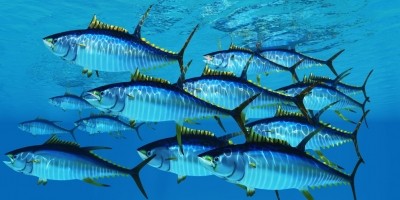CSI seafood: Thai Union tapping DNA forensics for fish traceability and authentication

Seafood is one of the most internationally traded food commodities, and tends to reach consumers only after having passed through convoluted and non-transparent supply chains – according to Thai Union, this exposes seafood to multiple food safety issues, particularly surrounding food fraud.
“Seafood has historically had to grapple with complex and opaque supply chains, which risk exposing it to issues of food fraud. This could take many forms—from dilution, substitution, and concealment, to unapproved enhancement, counterfeit, forgery and mislabelling,” Thai Union Group Innovation Director Dr Tunyawat Kasemsuwan told FoodNavigator-Asia.
“[In addition to] ripping off consumers, and having a negative impact on marine life, seafood fraud can be harmful to health—particularly when substitution and unapproved enhancement take place.”
With this in mind, Thai Union has put in place a number of strategies to combat food fraud within its organization, one of which is using the principles of forensic science, most commonly known to be used in crime-solving and investigations.
“Through the lab at our Global Innovation Center, we have been able to implement sophisticated methods of DNA barcoding and Single Nucleotide Polymorphisms (SNP) analysis (based on gene sequence differences between individual organisms) to verify the species of the fish and where they were caught,” Dr Kasemsuwan explained.
In this process, when attempting to identify a particular type of fish such as tuna, whether canned or frozen, to ascertain its origins and species, the tuna sample is sent to the lab where its DNA is extracted, put through Polymerase Chain Reaction (PCR), sequencing analysis to match it to samples from a database, then analysed for particular patterns identifying its geographical and species ID.
“This provides a further level of assurance to our customers and is an area where we are constantly innovating,” he added.
“In addition, we were also the first company globally to introduce a can tracker on canned tuna products, allowing consumers to trace their product back to species, vessel, ocean and fishing trip.”
Thai Union has also implemented what it calls the Combating Food Fraud and Food Defense Strategy organisation-wide, hoping to provide clearer guidance to employees on preventing food fraud and adulteration in the business.
The strategy defines measure and controls that are required to address and control any risks identified by the company e.g. around the areas of raw materials, ingredients, packaging and food.
“The Combating Food Fraud and Food Defense Strategy adds additional layers of security [against food fraud],” said Dr Kasemsuwan.
“[In this strategy], firstly we undertake vulnerability assessments to identify potential sources of food fraud within our supply chain. We then develop and implement control measures that minimize the chances of receiving fraudulent foodstuffs and address the potential vulnerabilities in our business units, facilities or processes.
“[That said], when it comes to food fraud, traceability is the first and most effective line of defense. Under our SeaChange sustainability strategy, we have built up the ability to trace our seafood back to the vessel or aquaculture farm.
“Additional layers of transparency and verification are also being put in place through the expansion of blockchain technology and our partnership with The Nature Conservancy to achieve 100% ‘on-the-water’ monitoring by 2025.”
Consumer concerns
Dr Kasemsuwan has also observed a higher level of food safety awareness amongst consumers after COVID-19 hit the region.
“While food safety has always been a concern for consumers in the APAC region, this has only intensified following the outbreak of COVID-19. People are now hyper-aware of their health and want to know that the food they are eating is safe and of a high-quality,” he said.
“Similarly, we are seeing a steep change in interest from consumers about the journey food takes to get to their tables. During the COVID-19 outbreak, consumers have tended to move away from raw food to food that is either processed or ready-to-eat which can be reheated, providing further peace of mind that the food they are eating is safe.”
He added that one of the key challenges to overcoming seafood fraud in the APAC region will lie in achieving traceability but there are many barriers in the way of this.
“[Solving] this will require a more sophisticated system for monitoring vessels and verifying traceability data between different parts of the supply chain. It also requires global consensus on acceptable standards for seafood traceability,” Dr Kasemsuwan said.
“That’s why we have worked with the Global Dialogue for Seafood Traceability (GDST), supporting trials [and] testing standards of interoperability. We have [also] made 100% traceability a key pillar of our commitment.”
Technology still key
Despite the many challenges, food safety in APAC has come a long way over the past decade in terms of legislations, standards and management systems – and Dr Kasemsuwan believes that as technologies in this area continue to improve, so will the overall safety environment.
“A series of private standards on food safety, traceability and food defense are being applied by the industry. There are [also] an increasing number of sophisticated technologies that are being brought to market [to] boost food safety and ensure authenticity,” he said.
“The next step is to keep refining these technologies while making them more scalable and affordable for widespread use by businesses big and small across the region.”
He also called for food safety regulators to keep up with such technology, so as not to hinder food safety progress in the region.
“For Thai Union, food innovation is aimed not only at new products but also safe food globally - Emerging and novel technology including AI are being applied to maximize resource utilisation [and] keep up with emerging hazards, diseases and contaminants.
“It is important that regulatory innovation be developed to keep up with novel technology and products to sustain food safety and the food industry.”
























